Why Customer Experience Is The Real Driver Of Brand Success?
Read More
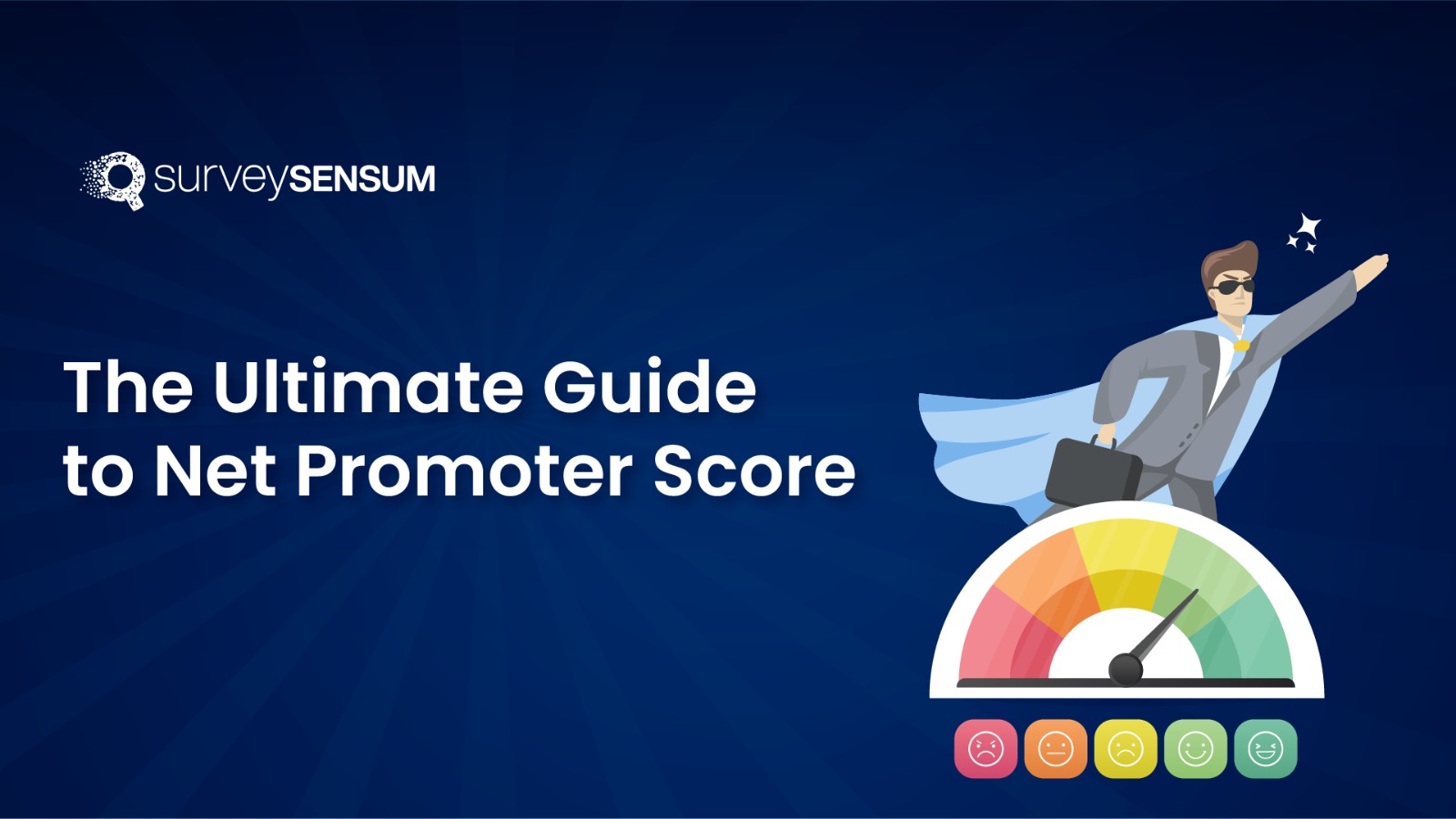
There are several factors that influence a customer in choosing a product or service. And one of the most important among them is the customer reviews.
In fact, 91% of customers regularly or occasionally read online reviews, and 49% trust these reviews as much as personal recommendations.
So, even if you do everything right, from having a great online presence to the best marketing strategy, one customer’s bad experience can adversely affect your business.
And according to a survey, customers with a bad experience are more likely to spread word of mouth than satisfied customers.
This means that you have to constantly get feedback from your customers, identify their problems, and take corrective measures to solve them asap. Doing so ensures a second chance for your business with the customers who had bad experiences and prevents such experiences for future customers.
Listening to your customers is the best way to understand what they like and dislike, and you can leverage it to optimize your business for improved performance.
And Net Promoter Score (NPS) is the best and easiest way to do this.
In this comprehensive guide, we will discuss what it is, its importance, how to calculate it, and more.
A Complete Breakdown: Types of NPS Surveys
NPS Benchmarking for Industries
What should you do with the NPS Feedback?
How to Improve your NPS Score?
Strategic Business Applications of Net Promoter Score (NPS)
How to Create an NPS Question that will generate the Right Responses?
NPS or Net Promoter Score is the measure of a business’s ability to win and retain customer loyalty.
Net Promoter Score ranges from -100 to 100 and measures the customers’ willingness to recommend your business to others.
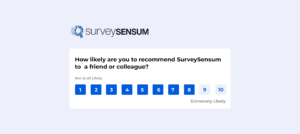
Net Promoter Score focuses on the fair treatment of customers and employees. Unlike traditional accounting which focuses on short-term business profits, NPS looks at the long-term picture.
It focuses on how well-perceived a business is through the eyes of its customers and employees.
In simple terms, NPS is the business equivalent of the lesson most of us were taught as children: Treat unto others as you would have them treat you.
Walt Bettinger, CEO of Charles Schwab, the global financial services firm, says so about Net Promoter Score —
Now that we know what NPS is, let’s go through its brief history.
NPS is the brainchild of three entities:
The concept of NPS was first introduced to the world through an HBR article, “The One Number You Need to Grow”, authored by Fred Reichheld.
The idea of NPS was to replace the complicated process of running a typical customer satisfaction survey. Net Promoter Score boils down the process to a single question whose responses can be used to determine customer satisfaction and, in some cases, employee satisfaction as well.
Running an NPS survey is like scaling the Everest summit.
There are several key aspects to it.
To make the best use of an NPS survey, you must identify the right type of survey to run, the scenario for which the survey will be used, and the question that will provide maximum responses.
Before setting up an NPS survey, you ought to know the various types of surveys that are available at your disposal. The two main types of NPS surveys are:
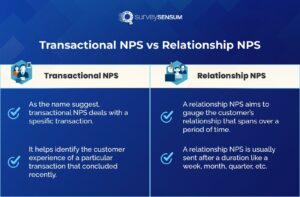
Surveys conducted to gauge customer loyalty (or their positive relationship) with the brand are referred to as relational surveys.
They ask customers about the overall experience of dealing with the brand, their satisfaction levels, and suggestions for improvement. They are conducted in the frequency of quarterly, half-yearly, or yearly.
Example: An on-demand video streaming service sends a monthly survey requesting feedback about its service quality.
Transactional Surveys aim to investigate the customer feedback for each transaction. The primary purpose of this type of survey is to figure out how to improve customer experience.
They are usually sent immediately or within a day or two from the completion of the transaction. Transactional surveys are apt for companies with a limited number of interactions with the customer and hence limited opportunities to seek feedback.
Example: A five-star hotel seeking feedback from a guest who completed a stay recently.
Take a look at our take on Transactional NPS vs Relationship NPS
| NOTE: tNPS is useful for businesses in the hospitality industry, but it’s not ideal for businesses that want to measure loyalty and build long-term relationships. Why? Because customers don’t usually recommend the business after a couple of interactions. |
But now that you’ve shared the survey, you’ll start gathering feedback. But, how’d you calculate your NPS Score?
Once you create your NPS survey, you can share it with your intended customers to get feedback. As you can see from the NPS question, the feedback will be a figure ranging from 0 – 10. And based on the responses, divide the customers into three categories:
→ Learn about color coding your NPS Scale.

Now, the general formula for calculating the NPS score is as follows.

So, for example, if the responses for 100 survey feedback are as follows
Then your percentages would be 25%, 55%, and 20%, respectively.
Therefore the NPS score would be (25% – 20%), which is +5.
A positive NPS is a good indication. However, an Net Promoter Score of 5 shows that there is plenty of room for improvement. We will discuss this further in the next section.
Also, follow up on the link to learn more about how to calculate NPS.
Now that you have calculated the NPS score, the question you should ask now is, whether your score is good or not.
As a thumb rule, if the NPS score is less than 0, it is a cause for worry. A positive NPS gives some level of comfort. In other words, an NPS score above ‘20’ can be considered to be good, anything above ‘50’ is great and anything above ‘70’ is excellent.
Any positive integer can be deemed to be a good NPS score since it indicates the overall positive sentiments of customers towards the business. However, the average NPS varies significantly from industry to industry. So, what constitutes a good NPS score for the hospitality industry may not apply to the retail industry.
If your NPS score is negative, then you need to make changes to your business immediately since you can expect more of your customers to leave your business.
The best approach is to identify the NPS scores of your competitors so you know where you stand.
NPS benchmarking is the process of comparing the NPS score of a company with its industry standards or competitors. The purpose of benchmarking is to understand your business’s performance with respect to others in the industry.
For instance, in the context of NPS in banking, a financial institution can evaluate its NPS score and compare it with other banks in the same sector. If the score falls below the industry benchmarks, it becomes imperative to investigate the reasons behind customer dissatisfaction and implement corrective measures.
Following are some steps to help benchmark your NPS:
Research and identify companies in your industry that are similar to your business. Consider factors like region, industry, type of service, and target audience to narrow down the list.
Calculate the average NPS score of your company and collect NPS data of your competitors or industry benchmarks. Analyze net promoter score data, by using the Text Analytics Software, to look for trends or patterns in the data, such as differences in NPS scores across different customer segments.
Compare your NPS score with industry standards or competitors. If the score is higher than the industry average, then you have more promoters and doing well than most of your competitors. On the other hand, if the score is lower, it may indicate that you need to focus more on improving your customer experience.
Make use of the benchmarking data to make necessary improvements in your business. This can include making changes to your product, service, or customer support. The bottom line here is to improve the overall customer experience of your business.
Take a look at the NPS average of different industries as of 2022. The result is based on the extensive survey conducted by Satmetrix.
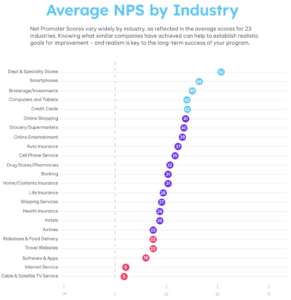
Now that we have discussed NPS benchmarks in industries let’s discuss the importance of NPS in your business.
Here are 10 strong reasons why you shouldn’t slack on calculating the NPS Score.
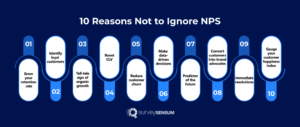
A core focus of business is to keep their customers happy, and NPS is the easiest way to understand how happy the customers are.
Keep reading to understand more about the benefits of NPS detail.
Create NPS Survey with SurveySensum!
Now that you know NPS is really important for your customer experience, it’s time to create the survey!
Now that you know what kind of surveys you can go after, it is time to create a Net Promoter Score survey. Be it a relational survey or transactional survey, these steps remain the same.
The title should be short, crisp, and self-explanatory. Your customers should ideally understand the motive of the survey from the title itself. You can use creative titles, provided they do not make the motive ambiguous.
Some suggestions for an NPS survey title are:
A brief description should help customers understand better why the survey is being conducted. It can also be used to specify whether the survey pertains to a specific transaction or is a periodical one that evaluates the customer experience over a period of time.
As we discussed before, an NPS survey will typically have only one question.
‘On a scale of 0-10, how likely is it that you would recommend [your business name] to your friends, family, or business associates?’
Your customers are taking their precious time and effort to give you feedback. That feedback is going to help improve your product/service. So it is basic etiquette to thank them for taking the time to give feedback.
NOTE: An efficient NPS software helps you create lucrative NPS surveys and launch them at the right touchpoint and at the right time. Also, the tool helps share alerts to the team when a detractor shares their feedback and analyzes all the feedback. Not only it’ll help you close the loop in time, but it will also help you create an efficient NPS program.
Launch Your First NPS Survey
You’ve launched the survey and started gathering feedback. Now, how’d you analyze so much feedback?
Now that you have sent the NPS survey at the right time, what should you do with the valuable customer feedback? How can you analyze it?
Here’s what you can do!
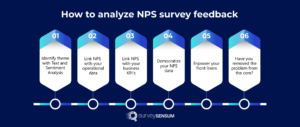
Know the problems of your customers and take action on them. To achieve the same, deep dive into the customers’ open responses and run text and sentiment analysis. Create a set of common topics and subtopics related to the product’s offerings, track the sentiment of the customers, identify the themes, and make a plan of action.
Plan a regular cadence meeting where all the departments discuss and prioritize CX initiatives based on themes identified from the open-ended, verbatims, and decide who will drive the specific initiative, timelines of it, etc.
Connecting your experience data with your operational data will give you a boost! If you are not doing it, you are not getting a likelihood of improvement in your business.
Your NPS program will yield far more significant insights when you’ll connect your experience data with your operational data residing in your CRM. You can deep dive into the collated data to identify the problem and take action on it.
Link your business KPIs with your NPS programs depending on which stage you are and what is more important to you; be it churn, retention, or net revenue. Understand detractors at all touchpoints across the channel and prioritize them considering your business outcome.
Your sales, marketing strategy, and support teams are the ones in touch with your customers. Empower them with insightful NPS data. But how can you do it?
Identify common themes from qualitative feedback with sentiment analysis. Prioritize the issues, categorize them based on the departments, and trigger a team notification to take instant action.
Your customer support can make or break your Customer Experience as they are the ones that engage with the customers on a daily business. They need to know how to build relationships with the customers and their sentiments. They should be able to care and empathize with the customer’s issue.
Empower them with the customers’ details by storing the NPS feedback in the CRM or help desk such that when they get a query from the same customer, they have everything they need to know about the customer right in front of them.
Don’t communicate the problems on an individual level rather empathize with the customer and get rid of the issue from the core. So, when the respondents revisit your brand and see that they have been heard, it will boost their loyalty and trust in you.
Given its significance, how do you improve your Net Promoter Score?
Analyze Your NPS Program With SurveySensum!
As discussed, if your business’s NPS score is lower than your competitors or the industry average, then it’s high time you improve it.
Following are a few pointers on how to improve your NPS score –
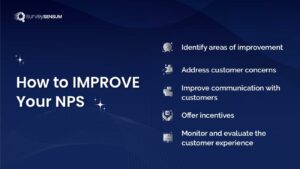
By taking a comprehensive approach to improving your NPS score, you can enhance the customer experience, build customer loyalty, and ultimately drive long-term success for your business.
Net Promoter Score can be strategically implemented across your organization to measure success or failure at various levels:
Businesses can gauge which of their customer teams, each serving different regions, performs best. This approach can help them identify the team delivering the highest customer satisfaction.
Businesses with physical locations can enable a tablet-based NPS survey at the store exit. This way, they can collect immediate feedback on customers’ experiences.
Given the significant time customers spend online, deploying NPS surveys on your website or app can help boost your score. These can be triggered at key moments in the user’s journey, like after a purchase or when they attempt to leave a page to capture timely feedback.
These are strategic locations to be selected based on business priorities, site structure, and user behavior on your website or app.
The Net Promoter Score Question is the epicenter of a survey. Its tone and structure will determine how customers will give their feedback. Also, there are different types of NPS questions for different scenarios. Some such questions and scenarios in which you can use them are listed below:
When you are just getting started with NPS surveys, you can always stick to the classic question,
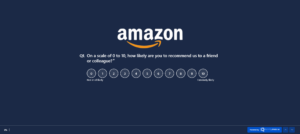
The benefits of this question are:
When you want feedback on a specific product or service of the company. In the previous question, replace the term ‘company’ with the product or service name.
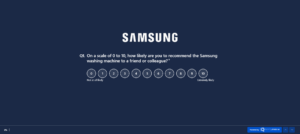
The benefits of this net promoter score question are:
When you want to use NPS surveys internally to gauge employee satisfaction.

The benefits of this question are:
The objective of a Net Promoter Score survey is to collect customer feedback in the form of a rating. But why did each customer give the specific rating that they gave? Are there specific reasons that have motivated the rating?
Open-ended questions that follow the net promoter score question help identify the same.

Alt txt: NPS follow-up question for customers
To learn more about the types of questions to ask in an NPS survey, take a look at our blog on NPS survey questions.
As a business that is running the Net Promoter Score survey, you ought to respond after the customer finishes the survey, This typically comes in the form of a ‘Thank you’ message.
Crafting the right ‘Thank you’ message is vital because their tone and messaging can help nudge the customer from being a detractor to a passive and ultimately to a promoter.
Here are a few thank-you messages that you can use for your promoters, passives, and detractors.
“Thanks for taking the time to give your feedback. We are thrilled to have you as a high-value customer. Your feedback will help us come up with product/service improvements that will make your experience better than what it is now.”
How does the note help retain customers who are promoters?
The note explicitly mentions that the customer is a high-value customer. This gives the customer the impression that they are exclusive and valuable to the company more than other customers.
This privilege makes them feel more attached to the brand and persuades them to promote it with their friends and colleagues.
“Thanks for taking the time to give your feedback. We will work on each and every suggestion that you have given. You will see a significant improvement in our offerings in the days to come.”
How does the note help retain customers?
The note establishes the company’s notion to work on the customer’s feedback. This will convince the passive customer that all their pain areas have been acknowledged.
The last statement gives an assurance that things will change soon, This helps reduce the possibility of passive customers looking for other alternatives. When the improvements happen and their level of satisfaction soars high, they will ultimately turn into promoters.
“Thanks for taking the time to give your feedback. We will work on each and every suggestion — positive and critical that you have given. Our team might reach out to you in the near future to understand more about the not-so-great experiences that you might have had, Be assured that we will do everything possible to deliver great experiences to you in the near future.”
How does the note help retain customers?
At the onset, it establishes the fact the business acknowledges both the positive and critical feedback given by the customer.
It also indicates that the team might reach out personally to identify what went wrong with each interaction. The final statement gives the assurance that the feedback will be used to improve the experience.
An NPS survey cannot be orchestrated manually. Also, there are several expectations about NPS that the C-suite and other stakeholders should be made aware of before the survey launch.
All these factors can be determined in the best possible way with NPS tools. With a great NPS tool in place, you can reduce manual effort and maximize productivity. Also, the tool should make it easy for customers or employees to give their ratings and suggestions easily.
Choosing the right NPS tool for your survey ensures that you gather accurate data and insights from your customers. The following are some factors to consider before selecting an NPS tool.
Choose an NPS tool that allows customizable surveys, for example, the option to use a 5-point NPS scale. This way, you can tailor the survey with essential branding elements, questions, and appealing design, making the survey experience more engaging for customers.
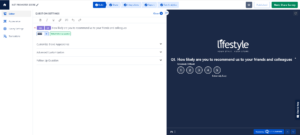
Consider a tool that offers multiple distribution options. This is important because you should be able to reach out to the customers through their preferred channels. For example, SurveySensum offers surveys through WhatsApp, a channel widely used by customers worldwide.
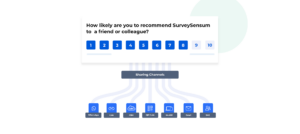
Ensure that the NPS tool provides robust data analysis and reporting capabilities. Look for features like conversation analytics, cross-tab analysis, and customer segmentation. This can help you gain valuable information about customer behavior and preferences.
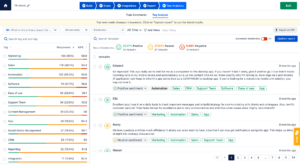
Choose an NPS tool that offers active integration with third-party tools. This can help streamline your workflow and improve your customer experience.
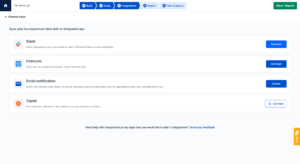
Ensure the tool you choose falls well within your budget and provides all the necessary features. You can also make use of the free version and trials of tools to understand whether it is the right fit for you.
Consider the above-mentioned factors and try to pick the right NPS tool.
To facilitate your research, we have compiled a list of the 15 best NPS tools in the market in 2024. You can go through it, analyze each, and pick the one best suited for your business.
Now, there are tons of tools in the market, and you cannot select a random one. You need to select from the most efficient NPS software that is responsive, efficient, and accurate with a neat user experience.
SurveySensum’s Net Promoter Score is one such top-ranking tool that helps businesses of all scales create NPS surveys without breaking into a sweat.
You can run NPS surveys through the omnichannel route that encompasses chat, email, web, and SMS. The unique attribute of SurveySensum is that — it is powered by Artificial Intelligence. Its added intelligence can listen, interact, engage, and turn customers into super fans.
Apart from helping you create and run NPS surveys instantly, SurveySensum also helps predict customer churn, uncover hidden patterns in customer behavior, and manage your customer experience centrally.
